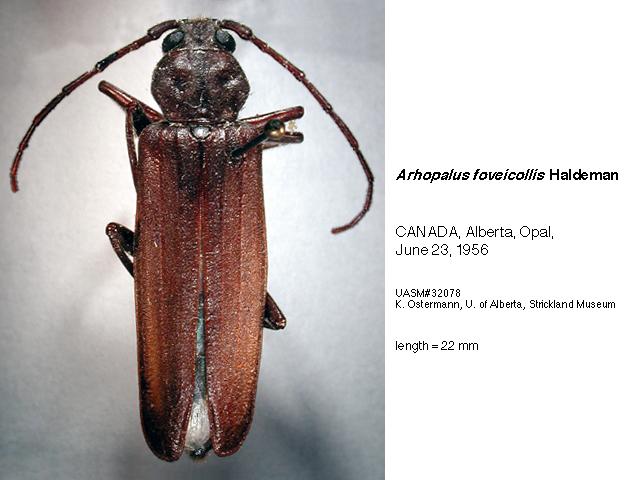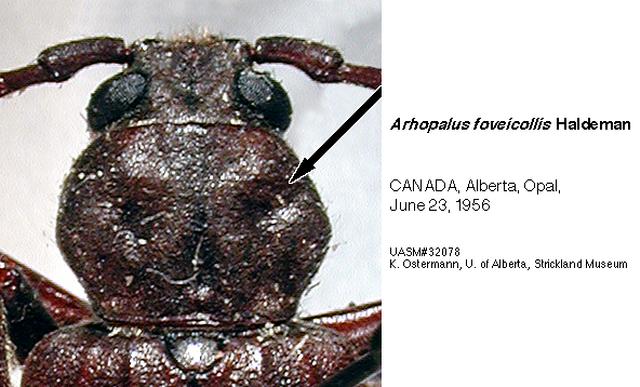Species Details
Arhopalus foveicollis
University of Alberta E.H. Strickland Entomological Museum Read more about this collection »
SeasonalityAdult flight period is June though August (Yanega 1996).
IdentificationBody robust, dark brown to blackish, dull. Head closely punctuate, antennae to apical 1/3 of elytra, with segments 8-11 as long as the preceding 3 together. Gula with a dense beard of long pale hairs, pronotum distinctly wider than long, sides usually rounded, rarely angular. Abdomen with 5th sternite truncate or feebly emarginated at apex. Females more robust than males, abdomen with 5th sternite rounded at the apex (Linsley 1962). Eyes not hairy, pronotal surface irregular with a pair of deep pits; elytra with distinct ridges. The range extends westward to overlap with that of a similar species A. asparatus (LeConte), which is possibly only a variant of A. foveicollis (Yanega 1996; Linsley 1962). Overall, A. foveicollis is most defined by their nicely rounded pair of pronotal pits, rounded pronotal profile and gradually abbreviated antennal segments.
Scientific Name
Arhopalus foveicollis
Habitat
Coniferous forests of North America east of the Rocky Mountains (Yanega 1996).
Seasonality
Adult flight period is June though August (Yanega 1996).
Identification
Body robust, dark brown to blackish, dull. Head closely punctuate, antennae to apical 1/3 of elytra, with segments 8-11 as long as the preceding 3 together. Gula with a dense beard of long pale hairs, pronotum…
Body robust, dark brown to blackish, dull. Head closely punctuate, antennae to apical 1/3 of elytra, with segments 8-11 as long as the preceding 3 together. Gula with a dense beard of long pale hairs, pronotum distinctly wider than long, sides usually rounded, rarely angular. Abdomen with 5th sternite truncate or feebly emarginated at apex. Females more robust than males, abdomen with 5th sternite rounded at the apex (Linsley 1962). Eyes not hairy, pronotal surface irregular with a pair of deep pits; elytra with distinct ridges. The range extends westward to overlap with that of a similar species A. asparatus (LeConte), which is possibly only a variant of A. foveicollis (Yanega 1996; Linsley 1962). Overall, A. foveicollis is most defined by their nicely rounded pair of pronotal pits, rounded pronotal profile and gradually abbreviated antennal segments.
Life History
Breeds in Pinus and Picea (Downie and Arnett 1996).
Conservation
No information available.
Diet Info
Larvae feed on the bases of dead pine and spruce trees; Pinus sp, P. rigida, P. strobes and Picea sp (Yanega 1996).
Range
This species ranges across most of Canada (Bousquet 1991), and is found in Alaska, Wisconsin and Maine in the United States.
References
Author
Bousquet, Yves
Title
Checklist of beetles of Canada and Alaska.
Publication Date
1991
Pages
430
Author
Yanega, D.
Title
Field Guide to northeastern longhorned beetles (Coleoptera: Cerambycidae).
Publication Date
1996
Pages
174 pp
Author
Downie, N. M. and R. H. Arnett
Title
The beetles of northeastern North America.
Publication Date
1996
Volume
1
Pages
880 pp.
Author
Linsley, E. G.
Title
The cerambycidae of North America, Part 2: taxonomy and classification of the Parandrinidae, Prionidae, Spondylinae, and Aseminae.
Publication Date
1962
Series Title
University of California Publications in Entomology
Volume
19
Pages
68-76
Specimen Information
There are 44 specimens of this Species.
UASM136552 - Arhopalus foveicollis
University of Alberta E.H. Strickland Entomological Museum
Place CollectedCanada: Alberta, Edmonton
Date Collected1967-07-23
UASM136553 - Arhopalus foveicollis
University of Alberta E.H. Strickland Entomological Museum
Place CollectedCanada: Alberta, Lethbridge
Collected ByGooding, R. H.
Date Collected1956-07-29



